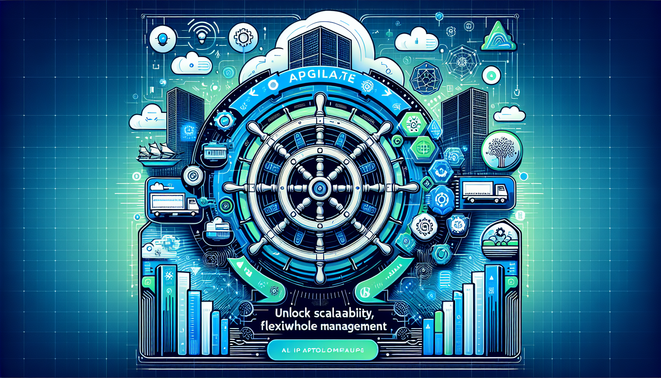Physical Address
304 North Cardinal St.
Dorchester Center, MA 02124
Physical Address
304 North Cardinal St.
Dorchester Center, MA 02124

Leveraging Kubernetes for AI Workloads: A Comprehensive Guide
Kubernetes offers an efficient framework for managing AI workloads, providing scalability, flexibility, and automation. This guide explores Kubernetes architecture for AI, deployment strategies, scaling techniques, and cost management practices, enhancing your orchestration capabilities.
Meta Summary
Optimize your AI workload management with Kubernetes. Learn about container orchestration, deployment strategies, and cost management to maximize performance and efficiency.
Key Takeaways
Kubernetes facilitates efficient deployment, scaling, and management of AI workloads.
Understanding Kubernetes architecture is crucial for optimal AI/ML operations.
Effective monitoring and cost management are vital for successful AI workload running on Kubernetes.
Introduction to AI Workloads and Kubernetes
AI workloads encompass computational tasks in machine learning and artificial intelligence. In cloud environments, they are pivotal for processing large datasets, deriving insights, and automating decision-making processes. Kubernetes—a leading open-source platform—is perfect for containerizing AI applications, enabling seamless deployment, scaling, and management across numerous hosts.
Note: Kubernetes is an industry-standard tool for managing containerized applications in powerful and automated ways.
Learning Objectives
Define AI workloads and their significance in cloud environments.
Describe how Kubernetes serves as a platform for managing these workloads.
AI workloads are essential across sectors like finance and healthcare, where they enhance decision-making through data-driven insights. Kubernetes provides a flexible structure for deploying these workloads, ensuring scalable and efficient operations.
Kubernetes Architecture for AI Workloads
Understanding Kubernetes architecture is essential to effectively deploy AI workloads. The core components include:
Node: A machine (virtual or physical) running containerized applications.
Cluster: A set of nodes grouped to optimize workload management.
Pod: The smallest deployable unit in Kubernetes; may contain multiple containers.
Controller: Manages and ensures the desired number of pods are operational.
Service: Defines a logical set of pods, establishing a policy for accessing them.
Learning Objectives
Explain the key components of Kubernetes architecture.
Discuss the role of container orchestration in AI/ML.
Kubernetes orchestrates containers, balancing workload distribution and facilitating high availability.
Deployment Strategies for AI/ML on Kubernetes
Deploying AI/ML workloads on Kubernetes includes several strategies:
Batch Processing: Suitable for tasks not requiring immediate feedback.
Stream Processing: Ideal for real-time data processing demands.
Microservices Architecture: Decomposes applications into small, independent services.
Learning Objectives
Identify various deployment models suited for AI workloads.
Demonstrate how to set up a basic AI workload on a Kubernetes cluster.
Exercise:
Deploy a simple AI model within a local Kubernetes cluster.
Craft a Helm chart for deploying multiple AI services.
Tip: Utilize custom resource definitions for enhanced AI workload management flexibility.
Scaling AI Workloads: Best Practices
Scaling AI workloads on Kubernetes can be executed through:
Horizontal Scaling: Increasing capacity by adding more instances, advantageous for parallelizable AI tasks.
Vertical Scaling: Boosting existing instance resources (CPU, RAM) for non-parallelizable tasks.
Learning Objectives
Outline techniques for efficiently scaling AI workloads on Kubernetes.
Assess the impact of horizontal versus vertical scaling.
Best Practice: Employ Kubernetes Horizontal Pod Autoscaler (HPA) to adjust pod numbers based on CPU utilization metrics.
Pitfall: Ignoring proper resource limits can lead to inefficient cluster usage and increased costs.
Monitoring and Managing Kubernetes Clusters
Consistent monitoring ensures AI workloads perform optimally. Tools like Prometheus and Grafana are invaluable for tracking Kubernetes environment metrics.
Learning Objectives
Illustrate tools for monitoring Kubernetes clusters and AI workloads.
Evaluate strategies for effective resource management.
Exercise:
Implement Prometheus and Grafana to monitor a Kubernetes-based AI workload.
Analyze resource metrics to propose optimization strategies.
Pitfall: Skipping resource metrics monitoring can lead to unanticipated downtime and waste.
Cost Management and Optimization
AI workloads on Kubernetes can be costly. Effective cost management strategies include:
Resource Quotas: Setting boundaries on resources a namespace can use.
Optimizing Requests and Limits: Allocating the correct resource amount for containers.
Learning Objectives
Analyze cost implications of running AI workloads on Kubernetes.
Suggest methods for optimizing resource usage to manage costs.
Best Practice: Regularly updating AI model dependencies can capitalize on performance improvements, lowering costs.
Case Study: A cloud provider’s Kubernetes-based framework reduced a major retail client’s AI predictive analytics costs by 20% while improving performance by 40%.
Case Studies and Real-World Applications
Real-world implementations highlight Kubernetes’ efficacy in AI/ML workloads:
Learning Objectives
Identify successful AI/ML workload case studies on Kubernetes.
Evaluate lessons from industry applications.
Case Study: A retail client optimized AI operations with Kubernetes, achieving major performance gains and cost cuts through tailored deployment and resource management.
Conclusion and Future Trends
Kubernetes is a vital tool for managing AI workloads, providing unmatched scalability, flexibility, and automation. As AI continues to evolve, Kubernetes will innovate to meet forthcoming challenges and opportunities.
Learning Objectives
Summarize key takeaways and advancements in Kubernetes for AI workloads.
Predict future trends affecting orchestration of AI workloads.
Future trends involve integrating AI with edge computing, bolstering AI deployment security, and refining AI lifecycle management tools.
Visual Aids Suggestions
Architecture Diagram: Detailed visualization of Kubernetes components interacting with AI workloads.
Screenshot: Depiction of a Kubernetes dashboard with AI deployment metrics.
Glossary
AI Workload: Computational tasks involving machine learning or artificial intelligence.
Kubernetes: An open-source platform for automating containerized applications’ deployment, scaling, and management.
Container Orchestration: Coordinated management of applications in containers.
Horizontal Scaling: Increasing a system’s capacity by adding more instances.
Vertical Scaling: Enhancing a machine’s power through additional CPU or RAM.
Knowledge Check
What is the primary function of Kubernetes in managing AI workloads?
A. To provide a database for AI applications
B. To automate deployment, scaling, and management of containerized applications
C. To replace AI algorithms with simpler models
D. To handle user authentication
Explain how horizontal scaling can impact AI model performance.
Further Reading
What is Kubernetes?
Kubernetes and Cloud-Native Apps
Kubernetes: Up & Running
By leveraging Kubernetes effectively, your AI workloads will perform efficiently, ensuring they are scalable and cost-effective, leading to successful cloud strategies.